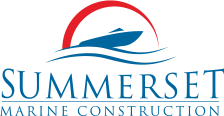Today’s lake and waterfront residents have so many options available to them to maximize their enjoyment of the water. Piers, platforms and lift systems have been significantly improved over the past few decades, in terms of materials used and design options. Additionally, just as new kinds of water crafts and toys keep emerging, waterfront solution design experts consistently find creative and practical new ways to store them and maximize their utility.
Water front residents have plenty of variables, from shoreline features to types of boats/ water crafts owned, and the road to finding the perfect solution starts with closely examining factors that should go into the design. Additionally, not everyone has the same priorities, thus each factor should be given weight based on the personal preferences and priorities.
The following areas of consideration are a good starting point, particularly with homeowners new to waterfront living:
Property features:
- Identify the best point(s) of access to the water from the property, in terms of natural shoreline features, trees and proximity to neighboring properties.
- How much of the shoreline would or should be used?
- Are there any existing structures near the water access that would be tied into the system?
- Consider natural foliage and existing landscaping elements, how they can be tied into the waterfront system as a seamless integration into the property.
Architectural style:
- The overall style and look of the waterfront system should compliment the color scheme, materials and architectural style of the main residence or other structures near the shoreline.
- Properties with boathouses should definitely have these treasured assets a focal point of any pier and docking system, central to their functionality; their access should be enhanced, not impeded.
- Minimalist versus classic pier systems may reflect the difference between traditional lake homes versus modern and contemporary.
Lifestyle/ Water Activities:
- Lifts and storage space for boats and watercrafts should be the first considerations in this area, current ownership and possible future.
- Sailboats require different lift configurations from ski or motor boats, as well as different types of storage needs. Ease of access and organization should be priorities to make boat use effortless.
- If leisure, relaxation and entertaining lakeside are priorities, consider orienting the main dock to accommodate that with appropriate seating areas and coverings.
- Smaller boats, watercrafts and toys should be easy to launch and store, ensuring their maximum use. Canoes, kayaks and paddleboards are inconvenient and dangerous obstacles on piers and platforms; specially designed racking systems and ramps keep the shoreline streamlined, functional and aesthetically pleasing.
Storage:
- Even the minimalist family needs a fair amount of lakeside storage space incorporated into their waterfront system. At the very least, seat cushions, lifejackets and a few floatables need a place to keep them out of sight and easily accessible.
- Storage needs generally increase exponentially with the family’s size and level of outdoor activity. Water sport accessories, such as paddles, pedals, skis, wakeboards, ropes, bumpers, etc. can easily be hidden, kept clean and dry and instantly available with clever shelving, racks and bins strategically incorporated into their waterfront design.
Budget:
- When setting a budget the perfect waterfront solution, the experts at Summerset Marine Construction advise an initial consultation to analyze the property owner’s access, lifestyle and priorities. Their seasoned staff and designers can then ensure that money is being allocated appropriately to address immediate needs while factoring in the owner’s priorities.
- Additionally, Summerset’s professionals are adept at planning and executing waterfront systems in stages, spreading the investment out over time, coinciding with evolving family lifestyles and needs.
